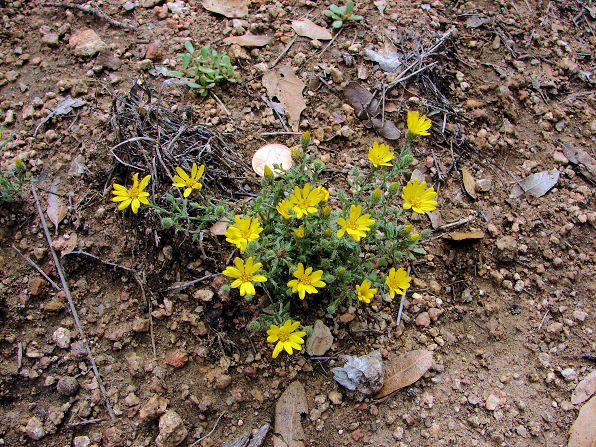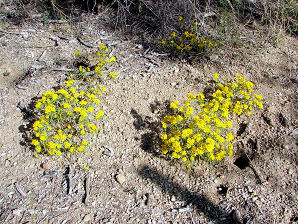Arizona Wild Flowers
Pictures, Photos, Images
Descriptions, Information, Reviews.
Manybristle Cinchweed, Pectis papposa.
We Are Proud Of Our SafeSurf Rating!
Click On Any Of The Following Links By Amazon.Com
For Books, & Videos About Wildflowers Of Arizona & The Southwest USA. No Obligation!
 |
| Manybristle Cinchweed, Pectis papposa. Penny Used To Compare Size Of Flowers Photo Taken At Yarnell, Arizona. August 31, 2008. |
|---|
 |
| Manybristle Cinchweed, Pectis papposa. Leaves & Flowers Photo Photo Taken At Yarnell, Arizona. September 30, 2006. |
 | |
| Manybristle Cinchweed, Pectis papposa. | Manybristle Cinchweed, Pectis papposa. |
|---|
Manybristle Cinchweed.
We wish to thank Wikipedia, the free encyclopedia for some of the information on this page. We share images and information with Wikipedia. Pectis papposa is a small, mounding annual usually no more than a foot high. Very often it is splayed circularly outward with its outward stems resting on the ground forming very tidy circles. Its opposite leaves have prominent oil glands, which are linear, and about 1 - 2� inches long by about � - � of an inch in width. Its small bright yellow flowers form at its stem ends and are comprised of both disk and ray flowers with the ray flowers being the most prominent. They also have oil glands. Its small seeds are wind carried. When crushed the whole plant is strongly aromatic. Manybristle Cinchweed�s growth is signaled by our summer monsoon rains and can be expected to bloom from the mid-summer to the early fall. The Zuni rubbed Chinchweed on the body as an aromatic perfume. It still is a traditional plant dye of the Hopi. The Zuni and Hopi both have used Pectis papposa as a seasoning for food. Chinchweed has many medicinal uses, but we do not recommend using it. Considered a good native, xeriscape plant. Especially in elevations between 2,500 to 4,800 feet.
Quick Notes:
Height: Up to about 12 inches tall and 20 inches wide.
Flowers: Bright yellow, up to about 1 - 2� inches long by about � - � of an inch in width.
Flowering Time: June through December.
Leaves: Green opposite leaves with prominent oil glands, linear, and about 1 - 2� inches long by about � - � of an inch in width.
Found: Native to the Sonoran and Mojave deserts reaching into the western fringes of the Chihuahuan Desert in southeastern Arizona and southwestern New Mexico. States of Arizona., California., Nevada., New Mexico., Utah. In Mexico: Baja California, Baja California Sur, Sinaloa, and Sonora.
Hardiness:
Soil pH requirements:
Sun Exposure:
Elevation: 2,500 to 6,000 Feet Naturally. Grows from 0 - 6,000 feet when cultivated.
Habitat: Sandy desert soils desert grasslands, dry woodlands, pinion pine - scrub oak, disturbed land areas, and roadsides.
Miscellaneous: Flowering Photos Taken At Yarnell, Arizona. September 30, 2006. And August 31, 2008.
|
We Are Proud Of Our SafeSurf Rating!
Click On Any Of The Following Links By Amazon.Com
For Books, & Videos About Wildflowers Of Arizona & The Southwest USA. No Obligation!
| © 1966 - Present, Audrey, Eve, & George DeLange |
